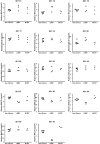The amyloid-β isoform pattern in cerebrospinal fluid in familial PSEN1 M139T- and L286P-associated Alzheimer's disease
- PMID: 22307680
- PMCID: PMC3493058
- DOI: 10.3892/mmr.2012.774
The amyloid-β isoform pattern in cerebrospinal fluid in familial PSEN1 M139T- and L286P-associated Alzheimer's disease
Abstract
There are several familial forms of Alzheimer's disease (AD) most of which are caused by mutations in the genes that encode the presenilin enzymes involved in the production of amyloid-β (Aβ) from the amyloid precursor protein (APP). In AD, Aβ forms fibrils that are deposited in the brain as plaques. Much of the fibrillar Aβ found in the plaques consists of the 42 amino acid form of Aβ (Aβ1-42) and it is now widely accepted that Aβ is related to the pathogenesis of AD and that Aβ may both impair memory and be neurotoxic. In human cerebrospinal fluid (CSF) several C- and N-terminally truncated Aβ isoforms have been detected and their relative abundance pattern is thought to reflect the production and clearance of Aβ. By using immunoprecipitation and mass spectrometry, we have previously demonstrated that carriers of the familial AD (FAD)-associated PSEN1 A431E mutation have low CSF levels of C-terminally truncated Aβ isoforms shorter than Aβ1-40. Here we replicate this finding in symptomatic carriers of the FAD-causing PSEN1 L286P mutation. Furthermore, we show that preclinical carriers of the PSEN1 M139T mutation may overexpress Aβ1-42 suggesting that this particular mutation may cause AD by stimulating γ-secretase-mediated cleavage at amino acid 42 in the Aβ sequence.
Figures


Similar articles
-
Distinct cerebrospinal fluid amyloid beta peptide signatures in sporadic and PSEN1 A431E-associated familial Alzheimer's disease.Mol Neurodegener. 2010 Jan 14;5:2. doi: 10.1186/1750-1326-5-2. Mol Neurodegener. 2010. PMID: 20145736 Free PMC article.
-
Effects of gamma-secretase inhibition on the amyloid beta isoform pattern in a mouse model of Alzheimer's disease.Neurodegener Dis. 2009;6(5-6):258-62. doi: 10.1159/000264639. Epub 2009 Dec 3. Neurodegener Dis. 2009. PMID: 19955704 Free PMC article.
-
Elevation of beta-amyloid peptide 2-42 in sporadic and familial Alzheimer's disease and its generation in PS1 knockout cells.J Biol Chem. 2001 Nov 16;276(46):42645-57. doi: 10.1074/jbc.M102790200. Epub 2001 Aug 28. J Biol Chem. 2001. PMID: 11526104
-
Evidence For and Against a Pathogenic Role of Reduced γ-Secretase Activity in Familial Alzheimer's Disease.J Alzheimers Dis. 2016 Apr 4;52(3):781-99. doi: 10.3233/JAD-151186. J Alzheimers Dis. 2016. PMID: 27060961 Review.
-
Evaluation of the performance of novel Aβ isoforms as theragnostic markers in Alzheimer's disease: from the cell to the patient.Neurodegener Dis. 2012;10(1-4):138-40. doi: 10.1159/000334537. Epub 2012 Feb 1. Neurodegener Dis. 2012. PMID: 22302034 Review.
Cited by
-
Alzheimer's Disease Biomarker Analysis Using Targeted Mass Spectrometry.Mol Cell Proteomics. 2024 Feb;23(2):100721. doi: 10.1016/j.mcpro.2024.100721. Epub 2024 Jan 20. Mol Cell Proteomics. 2024. PMID: 38246483 Free PMC article. Review.
-
Distinct patterns of APP processing in the CNS in autosomal-dominant and sporadic Alzheimer disease.Acta Neuropathol. 2013 Feb;125(2):201-13. doi: 10.1007/s00401-012-1062-9. Epub 2012 Dec 6. Acta Neuropathol. 2013. PMID: 23224319 Free PMC article.
-
Cerebrospinal fluid and blood biomarkers for neurodegenerative dementias: An update of the Consensus of the Task Force on Biological Markers in Psychiatry of the World Federation of Societies of Biological Psychiatry.World J Biol Psychiatry. 2018 Jun;19(4):244-328. doi: 10.1080/15622975.2017.1375556. Epub 2017 Oct 27. World J Biol Psychiatry. 2018. PMID: 29076399 Free PMC article. Review.
-
Amyloid β Proteoforms Elucidated by Quantitative LC/MS in the 5xFAD Mouse Model of Alzheimer's Disease.J Proteome Res. 2023 Nov 3;22(11):3475-3488. doi: 10.1021/acs.jproteome.3c00353. Epub 2023 Oct 17. J Proteome Res. 2023. PMID: 37847596 Free PMC article.
-
The effects of different familial Alzheimer's disease mutations on APP processing in vivo.Alzheimers Res Ther. 2017 Feb 16;9(1):9. doi: 10.1186/s13195-017-0234-1. Alzheimers Res Ther. 2017. PMID: 28209190 Free PMC article.
References
-
- Hardy JA, Higgins GA. Alzheimer's disease: the amyloid cascade hypothesis. Science. 1992;256:184–185. - PubMed
-
- Lemere CA, Blusztajn JK, Yamaguchi H, Wisniewski T, Saido TC, Selkoe DJ. Sequence of deposition of heterogeneous amyloid beta-peptides and APO E in Down syndrome: implications for initial events in amyloid plaque formation. Neurobiol Dis. 1996;3:16–32. - PubMed
-
- Rovelet-Lecrux A, Hannequin D, Raux G, et al. APP locus duplication causes autosomal dominant early-onset Alzheimer disease with cerebral amyloid angiopathy. Nat Genet. 2006;38:24–26. - PubMed
-
- Beher D, Wrigley JD, Owens AP, Shearman MS. Generation of C-terminally truncated amyloid-beta peptides is dependent on gamma-secretase activity. J Neurochem. 2002;82:563–575. - PubMed
-
- Portelius E, Price E, Brinkmalm G, et al. A novel pathway for amyloid precursor protein processing. Neurobiol Aging. 2011;32:1090–1098. - PubMed
Publication types
MeSH terms
Substances
LinkOut - more resources
Full Text Sources
Medical

